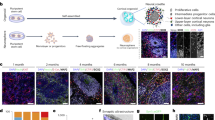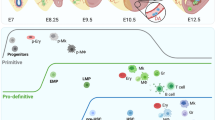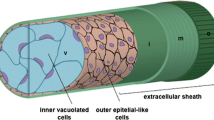Summary
Previous grafting experiments have demonstrated that cells from non-contiguous positions within developing and regenerating limbs differ in a property referred to as positional identity. The goal of this study was to determine how long the positional identity of axolotl limb blastema cells is stable during culture in vitro. We have developed an assay for posterior positional properties such that blastema cells can be cultured and then grafted into anterior positions in host blastemas, to determine if they can stimulate supernumerary digit formation. We report that posterior blastema cells are able to maintain their positional identities for at least a week in culture. In addition, we observed that blastema cells are able to rapidly degrade collagenous substrates in vitro, a property that apparently distinguishes them from limb cells of other vertebrates. These results provide information regarding the time boundaries within which the positional properties of blastema cells can be studied and manipulated in vitro.
Similar content being viewed by others
References
Bryant SV, Iten L (1974) The regulative ability of the limb regeneration blastema of Notophthalmus viridescens: Experiments in situ. Roux's Arch Dev Biol 174:90–101
Bryant SV, Iten LE (1977) Intercalary and supernumerary regeneration in regenerating and mature limbs of Notophthalmus viridescens. J Exp Zool 202:1–16
Bryant SV, French V, Bryant PJ (1981) Distal Regeneration and Symmetry. Science 212:993–1002
Bryant SV, Gardiner DM, Muneoka K (1987) Limb development and regeneration. Am Zool 27:675–696
Conn ME, Dearlove GE, Dresden MH (1979) Selection of a chemically defined medium for culturing adult newt forelimb regenerates. In Vitro 15:409–414
Dollé P, Izpisua-Benmonte J-C, Falkenstein H, Renucci A, Duboule D (1989) Coordinate expression of the murine Hox-5 complex homoeobox-containing genes during limb pattern formation. Nature 342:767–772
Dresden MH, Gross J (1970) The collagenolytic enzyme of the regenerating limb of the newt Triturus viridecens. Dev Biol 22:129–137
Ferretti P, Brookes JP (1988) Culture of newt cells from different tissues and their expression of a regeneration-associated antigen. J Exp Zool 247:77–91
Gardiner DM, Bryant SV (1989) Organization of positional information in the axolotl limb. J Exp Zool 251:47–55
Gardiner DM, Gaudier C, Bryant SV (1992) Mouse limb bud cells respond to retinoic acid in vitro with reduced growth. J Exp Zool 263:406–413
Gardiner DM, Muneoka K, Bryant SV (1986) The migration of dermal cells during blastema formation in axolotls. Dev Biol 118:488–493
Grillo HC, Lapiere CM, Dresden MH, Gross J (1968) Collagenolytic activity in regenerating forelimbs of the adult newt (Triturus viridescens). Dev Biol 17:571–583
Hayamizu TF, Bryant SV (1992) Retinoic acid respecifies limb bud cells in vitro. J Exp Zool: 263:423–429
Hayamizu TF, Sessions SK, Wanck N, Bryant SV (1991) Effects of localized application of transforming growth factor β1 on developing chick limbs. Dev Biol 145:164–173
Honig LS (1983) Polarizing activity of the avian limb examined on a cellular basis. In: Fallon JF, Caplan AI (eds) Limb development and regeneration. A R Liss, Inc, New York, pp 99–108
Izpisúa-Belmonte J-C, Tickle C, Dollé P, Wolpert L, Duboule D (1991) Expression of the homebox Hox-4 genes and the specification of position in chick wing development. Nature 350: 585–589
Jabaily JA, Blue P, Singer M (1982) The culturing of dissociated newt forelimb regenerate cells. J Exp Zool 219:67–73
MacCabe AB, Gasseling MT, Saunders JW (1973) Spatiotemporal distribution of mechanisms that control outgrowth and anteroposterior polarization of the limb bud in the chick embryo. Mechanism Ageing Dev 2:1–12
Muneoka K, Bryant SV (1984) Cellular contribution to supernumerary limbs in the axolotl, Ambystoma mexicanum. Dev Biol 105:166–178
Muneoka K, Holler-Dinsmore G, Bryant SV (1986) Intrinsic control of regenerative loss in Xenopus laevis limbs. J Exp Zool 240:47–54
Muneoka K, Holler-Dinsmore GV, Bryant SV (1985) A quantitative analysis of regeneration from chimaeric limb stumps in the axolotl. J Embryol Exp Morphol 90:1–12
Nohno T, Noji S, Koyama E, Ohyama K, Myokai F, Kuroiwa A, Saito T, Taniguchi S (1991) Involvement of the Chox-4 chicken homeobox genes in determination of anteroposterior axial polarity during limb development. Cell 64:1197–1205
Shi C, Muneoka K (1992) Position-specific growth of mouse limb bud cells in vitro. Dev Biol 151:9–17
Tank PW, Carlson BM, Connelly TG (1976) A staging system for forelimb regeneration in the axolotl, Ambystoma mexicanum. J Morphol 150:117–128
Tank PW, Connelly TG, Bookstein FL (1985) Cellular behavior in the anteroposterior axis of the regenerating forelimb of the axolotl, Ambystoma mexicanum. Dev Biol 109:215–223
Tickle C (1981) The number of polarizing region cells required to specify additional digits in the developing chick wing. Nature 289:295–298
Tickle C, Alberts B, Wolpert L, Lee J (1982) Local application of retinoic acid to the limb bond [sic] mimics the action of the polarizing region. Nature 296:564–566
Tickle C, Summerbell D, Wolpert L (1975) Positional signalling and specification of digits in chick limb morphogenesis. Nature 254:199–202
Yokouchi Y, Sasaki H, Kuroiwa A (1991) Homeobox gene expression correlated with the bifurcation process of limb cartilage development. Nature 353:443–445
Author information
Authors and Affiliations
Additional information
Correspondence to: S.V. Bryant
Rights and permissions
About this article
Cite this article
Groell, A.L., Gardiner, D.M. & Bryant, S.V. Stability of positional identity of axolotl blastema cells in vitro. Roux's Arch Dev Biol 202, 170–175 (1993). https://doi.org/10.1007/BF00365307
Received:
Accepted:
Issue Date:
DOI: https://doi.org/10.1007/BF00365307




